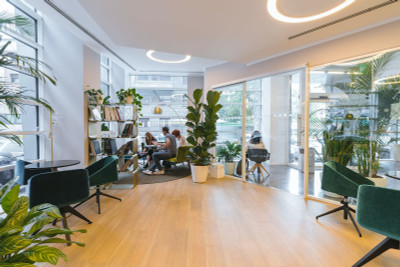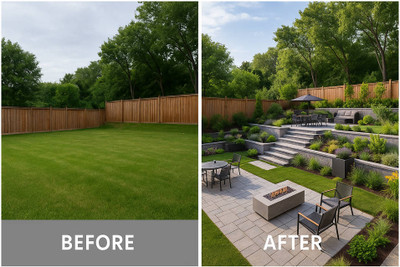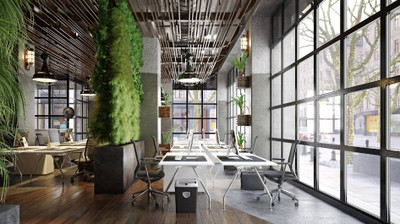What Are Green Spaces in Landscaping?
Posted by Jason Wyrwicz on May 8th 2025
Green spaces have become a focal point in contemporary landscaping and interior-exterior design planning. Architects, store managers, and interior designers have started looking for ways to incorporate nature into landscapes because they know how much it affects people's health and wellness.
This in-depth guide looks into what green spaces are in the context of landscaping, why they are important for people, and how they can be integrated effectively into urban, commercial, and residential settings.
If you are looking to revitalize your business environment—whether it’s an office, a retail store, or a public space—keep reading to find out how to make your surroundings vibrant and eco-friendly.
What Are Green Spaces?

Generally, green spaces are areas designed for landscaping features and vegetation. They often include trees, shrubs, flowers, grass, and various other forms of greenery that beautifully blend throughout the city, inside offices, outside residential buildings, and many other places.
When incorporated into urban settings, green spaces create a corridor of nature in the middle of concrete surroundings. Something as simple as placing a small indoor planter box can bring a sense of calm, improve air quality, and subtly reconnect people with nature—even in the heart of a bustling city.
If we focus on landscaping, green space is more than just plant life – it is a strategic design that integrates living elements seamlessly into built environments.
Although this integration can be purely aesthetic for some, adding green spaces can also be highly functional. While working on an outdoor design, you can plan spaces for relaxation and recreation using fiberglass planters that are built to last. For example, a rooftop garden can capture rainwater, and a cluster of planters in a retail store can offer a natural ambiance for visitors.
Natural vs Designed Green Spaces
Green Spaces can be either natural or designed – let’s see how they differ:
Types of Green Spaces in Landscaping
Architects and interior designers categorize green spaces based on the environment in which they are created and maintained. Here are key categories along with their characteristic features:
Residential Green Spaces

As the name suggests, residential green spaces are the ones found in and around homes, including:
- Lawns: A classic form of green space, offering open areas for recreation and visual appeal. They can range from small patches in front yards to large expanses in gated communities.
- Private gardens: These often feature decorative flowers, herbs, or even vegetable plots. Gardens can elevate property aesthetics while providing opportunities for personal enjoyment, relaxation, and even farm-to-table experiences.
- Courtyards: Enclosed or semi-enclosed areas that bring fresh air and sunlight into residential buildings. Courtyards can be adorned with potted plants or small water features, creating a personal sanctuary.
- Planters: Especially useful in small homes or apartments with limited outdoor areas, garden planters allow residents to bring greenery to patios, balconies, or window sills.
Commercial Green Spaces

Commercial green spaces are what make your workplace more welcoming and calming, as green color is known for its relaxing effects. Here are examples of where you can incorporate green spaces:
- Office parks: Large-scale landscaped areas surrounding or adjacent to corporate buildings. Office parks often incorporate walkways, seating, and water features for employees to enjoy breaks or informal gatherings.
- Green rooftops: Many forward-thinking businesses leverage the rooftops of their buildings to create lush gardens. This not only improves the visual impact but can also help regulate internal temperatures, reduce stormwater runoff, and contribute to employee wellness.
- Planters: In commercial lobbies, corridors, or exteriors, large planters can host palm trees, ferns, or ornamental grasses, enhancing the ambiance. Often made from durable materials like fiberglass or metal, these planters help businesses inject greenery into otherwise drab spaces.
Urban/Public Green Spaces

Green spaces in urban and public areas attract visitors and help bring communities together. They’re perfect for picnics, gatherings, and relaxing outdoors on a sunny day. Here are some common spots where families and friends come together to enjoy good weather:
- Community Parks: Publicly accessible parks with trails, sports facilities, playgrounds, and open fields. These spaces foster community engagement and recreational activity.
- Green Corridors: Linear green belts such as parkways, riverbanks, or nature trails that connect different parts of a city. They often provide walking, cycling, or jogging paths and serve as critical wildlife corridors.
- Planters: In urban sidewalks, plazas, and courtyards, planters are strategic solutions when in-ground planting is not feasible. They can also guide pedestrian traffic and define communal zones.
Residential vs Commercial vs Urban Green Spaces: Key Features and Benefits
As shown, each environment calls for different design considerations and purposes. Nevertheless, the common thread remains the emphasis on greenery to promote sustainability, beauty, and functionality.
Why Green Spaces Matter
Green spaces are integral not only for their aesthetic value but also for the wide-ranging advantages they bring to people and the environment. These benefits can be broken down into three main categories: environmental, social, and economic.
- Environmental Benefits
Improved Air Quality Plants perform photosynthesis, absorbing carbon dioxide and releasing oxygen. They also trap dust and pollutants on their leaves, purifying the air around them. This effect can be especially crucial in densely populated commercial districts where vehicle emissions and industrial activities contribute to poor air quality.
- Reduced Urban Heat Island Effect
Cities with extensive concrete and asphalt surfaces tend to absorb and retain heat, elevating local temperatures. Green roofs, parks, and tree-lined streets help mitigate this effect by providing shade and through the natural cooling process of evapotranspiration.
- Stormwater Management
Green spaces, especially vegetated rooftops and permeable landscapes, absorb rainwater, reducing surface runoff and lowering the risk of flooding. Plants and soil also filter pollutants from stormwater, contributing to cleaner waterways.
Social Benefits
- Community Engagement
Parks and community gardens become natural meeting spots. They encourage social interaction and can foster a sense of collective responsibility for maintaining shared resources.
- Stress Reduction
Scientific studies consistently show that people exposed to green environments experience reduced stress levels and improved mental health outcomes. Employees who have access to greenery in or around their workplaces often report higher job satisfaction and lower burnout rates.
- Public Health Improvements
Encouraging outdoor activity—whether it is a stroll in a local park or a break spent in a rooftop garden—helps combat sedentary lifestyles. Green spaces can thus play a part in improving community-wide physical health.
Economic Benefits
- Increased Property Value
Properties near well-designed green spaces typically command higher resale or rental values. For commercial buildings, adding green roofs or well-landscaped grounds can attract high-value tenants and boost brand reputation.
- Support for Tourism
Cities with extensive parks and unique green installations—such as vertical gardens or botanical displays—often become tourist magnets. This influx of visitors provides a boost to local businesses, restaurants, and hotels.
- Lower Operational Costs
Green roofs and walls can act as natural insulators, reducing cooling and heating needs. Over time, these energy savings can be substantial for large buildings. Additionally, strategic green design can help cut down on water usage by capturing rainwater and reducing runoff.
Green Space Design Tips
Designing effective and sustainable green spaces requires thoughtful planning and a balanced approach to aesthetics, utility, and environmental stewardship. The tips below will help guide you through essential considerations:
Use Native Plants

Native species are better adapted to local climate, soil, and precipitation patterns, reducing the need for fertilizers, pesticides, and excessive watering. They also support local pollinators and wildlife. Using native plants in your planters will reduce the need to maintain them and improve their longevity.
Incorporate Walkways and Water Features

One of the best ways to manage the pedestrian flow and protect plants from being trampled is to place them along the pathway. Alternatively, a central water feature like a small fountain or pond can offer soothing sounds and regulate ambient temperature and humidity both indoors and outdoors.
Prioritize Biodiversity and Accessibility

When incorporating green spaces, it’s also a good idea to add a diverse range of plant species. This can help promote a healthier ecosystem and attract beneficial insects and birds. Besides, make sure your space is inclusive, meaning it includes ramps or wide walkways for wheelchairs, and consider seating at varying heights for users of different abilities.
Maintenance Considerations

Regular upkeep is vital, especially if you want to ensure your green space contributes to the ambiance of the place. To do this, consider mowing, pruning, watering, and weeding your plants. Having a schedule will also help you keep track of each plant.
For commercial spaces, consider professional landscaping services that specialize in environmentally friendly practices like composting and drip irrigation.
Use Planters to Add Greenery in Paved or Difficult-to-Plant Areas

Many urban environments lack adequate soil depth. Long planters provide a practical solution to add shrubs, flowers, or ornamental grasses on any concrete surface.
In commercial settings, sturdy fiberglass planters offer both durability and design flexibility, allowing you to tailor greenery to your brand image. They are easy to customize and can be tailored to match your brand design down to the tiniest detail.
By blending the tips we’ve shared above, your green space will be sustainable and look stunning in any location. A well-thought-through design is your key to keeping the greenery vibrant and functional over time.
Enhance Your Urban Space and Create a Greener and More Inviting Environment with Durable Planters
Green Space vs Hardscaping
When designing green spaces, many architects incorporate hardscaping elements to create a well-balanced and functional outdoor layout that blends nature with structure. To understand how the two differ, see below:
Balancing green space and hardscape can help designers achieve a balance of natural and functional environments in urban spaces.
Real-World Examples of Businesses Using Green Spaces and Hardscaping
At Pots Planters & More, we’ve worked with clients who successfully used both green spaces and hardscaping in urban spaces. Here is how we helped them improve the functionality and visual appeal of their outdoor environments:
1. Corporate Office Complex
Client: A tech campus in Seattle
Solution: The company wanted to create inviting break areas within its modern courtyard. By integrating large fiberglass planters with native plants alongside stone pavers and minimalist benches, the space became both functional and calming. The durable planters withstood heavy foot traffic and weather changes while softening the space with greenery.
2. Boutique Hotel
Client: Luxury hotel in Scottsdale
Solution: The hotel upgraded its outdoor lounge and pool area by pairing custom-colored fiberglass pots with natural stone flooring. The planters added elegance and a splash of color, helping define pathways and seating zones. The combination of lush plants and sleek hardscaping offered guests a polished yet relaxing atmosphere.
3. Restaurant Patio
Client: Upscale bistro in Portland
Solution: To create year-round outdoor dining, the restaurant used raised garden beds and fiberglass planters filled with herbs and seasonal flowers. These sat beside flagstone paths and gravel areas, enhancing the charm and functionality of the space. The planters also helped delineate dining zones and added natural privacy screens.
How Urban Planners and Designers Use Green Spaces
Green spaces can be used solely to enhance urban places – this is often an affordable and quick solution for environments that lack the color and a touch of nature.
At Pots Planters & More, our durable fiberglass planters have made the following places more inviting and less intimidating:
- Government buildings: Many government buildings incorporate green rooftops or courtyard gardens, creating calming spaces for employees and visitors. These areas not only offer a place to relax but also contribute to a more sustainable environment.
- Hospitals: Healing or therapeutic gardens are increasingly common in healthcare settings. Patients with views of greenery or access to gardens often experience improved recovery times and reduced stress.
- Airports: In airports, landscaped terraces and communal gardens enhance the travel experience, providing passengers with peaceful spots to unwind before flights. These areas help reduce stress and improve the overall atmosphere of the airport.
Challenges and Solutions
While green spaces hold immense value, implementing them is not without obstacles. Below are some common challenges, along with suggested solutions:
Space Constraints
- Challenge: Urban areas and commercial environments often have limited ground-level space for gardens or lawns.
- Solution: Utilize vertical gardens or green roofs. Planters can transform sidewalks and courtyards into vibrant mini-gardens without requiring large swaths of land. Look for underutilized spaces such as building rooftops or balconies.
Water Usage
- Challenge: Maintaining plant life can demand a lot of water, which might be scarce or expensive.
- Solution: Implement drip irrigation systems that direct water precisely where it is needed. Harvest rainwater through collection systems on rooftops or downspouts. Choose drought-resistant or native plant species that thrive with minimal watering.
Maintenance Costs
- Challenge: Ongoing costs for pruning, fertilizing, pest control, and irrigation can be high, especially for large green spaces.
- Solution: Employ low-maintenance plants suited to local conditions. Consider adopting an integrated pest management approach that uses natural predators or organic methods to control pests instead of chemicals. Periodic professional consultations can also help identify ways to streamline maintenance.
Conclusion – Bringing It All Together
Green spaces are no longer just aesthetic additions; they have become vital components of modern, sustainable design. Whether you are a store manager striving to create a welcoming shopping environment, an architect shaping the skyline, or an interior designer bringing nature indoors, integrating green elements can elevate your project’s appeal, functionality, and eco-friendliness.
From residential lawns and courtyards to commercial rooftop gardens and public community parks, greenery offers undeniable benefits—lower stress, improved air quality, and heightened property values among them.
Ready to explore sustainable landscaping choices for your own business environment? Explore our planter range to find the right fit for your green space goals, and discover how a simple addition of greenery can transform any space into a healthier, more inspiring place to work, shop, or relax.






